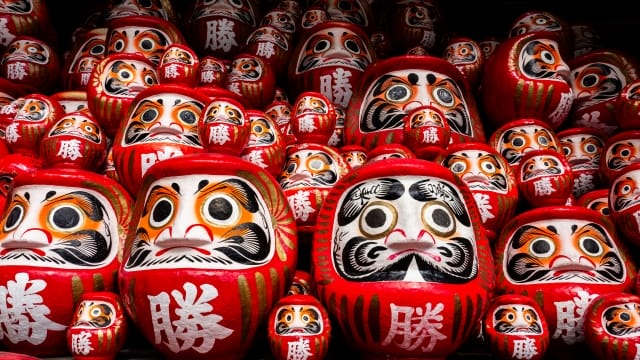The history and origins of Daruma dolls
- Connection to Bodhidharma: Daruma dolls are modeled after the meditation pose of Bodhidharma (known as Daruma Daishi in Japan), who meditated facing a wall for nine years. This meditative posture later inspired the creation of Daruma dolls.
- Introduction to Japan: Bodhidharma is recognized as the founder of Zen Buddhism, which spread from China to Japan. In the Kamakura period, Japanese Zen Buddhism highly regarded Bodhidharma, leading to the creation of scrolls and talismans depicting him.
- Evolution of Daruma: The prototype of Daruma dolls originated from the “Tumbler doll,” known in Japan as “Okiagari-koboshi.” This concept arrived in Japan during the Muromachi period. By the Edo period, Daruma dolls that mimicked Bodhidharma’s meditative posture emerged, symbolizing perseverance and resilience.
- Color and Significance: Initially, Daruma dolls were yellow, reflecting the color of monks’ robes in India. However, in Japan, red became the dominant color due to its association with warding off evil spirits.
This information highlights how Bodhidharma’s historical and cultural background influenced the evolution of Daruma dolls in Japanese culture, eventually becoming a symbol of good fortune.
Design and meaning
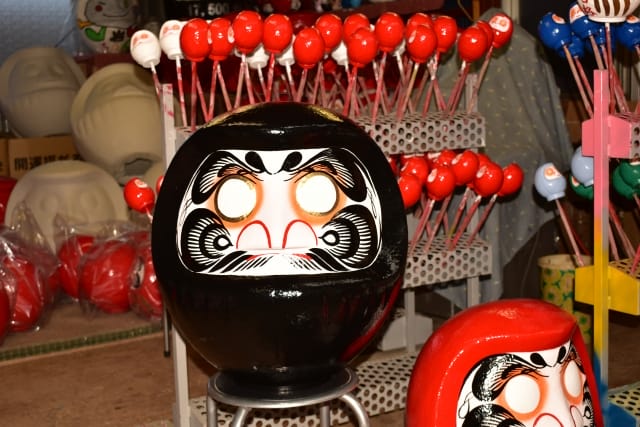
Design of Daruma Dolls
- Varied Expressions: Traditional Daruma often had stern faces, but modern designs include smiling faces and even animal-like appearances.
- Regional Features: Different regions in Japan have unique Daruma styles. For example, the Takasaki Daruma in Gunma Prefecture features cranes on the eyebrows and turtles on the mustache, with gold characters for prosperity and safety. Other regions like Miyagi and Saitama also have distinct Daruma designs.
Colors and Their Meanings
- Red: Traditionally used for warding off evil spirits and symbolizes household safety, health, and good fortune.
- White: Represents the power of achieving goals, often used for wishes like passing exams or fulfilling big ambitions. White Darumas can also amplify the powers of other colored Darumas.
- Yellow: Associated with wealth and bountiful harvests.
- Black: Known for business prosperity and warding off misfortune.
- Green: Symbolizes health and longevity.
- Pink: A relatively newer color, representing romantic success.
Eye Painting Tradition
- The practice of painting the eyes of a Daruma doll involves filling in the left eye while making a wish, and then the right eye once the wish is fulfilled. This custom represents the “Aun” (阿吽) concept, with the left eye signifying the beginning “A(阿)” and the right eye the end “Un(吽)”. If the wish remains unfulfilled, it is customary to fill in the right eye at the end of the year or fiscal year as a sign of gratitude and closure.
Daruma Doll Tattoos: Meaning, Design, and Cultural Significance
Daruma doll tattoos are rich in symbolism and meaning, deeply rooted in Japanese culture and tradition. These tattoos are often chosen for their representation of luck, success, and perseverance towards goals. The Daruma doll itself, originating from the story of Bodhidharma, the founder of Zen Buddhism, symbolizes perseverance and resilience in the face of adversity.
In terms of design and symbolism, Daruma doll tattoos can vary significantly:
- Classic Daruma Doll Design: Often red with large eyes, this design symbolizes good fortune and is a popular choice for those seeking strength and perseverance.
- Daruma Doll with One Eye: This specific design is chosen by individuals who are determined to achieve a particular goal. The one-eyed Daruma represents a goal or wish that is yet to be fulfilled. Once the goal is accomplished, the second eye is traditionally painted in.
- Combination with Other Elements: Some people combine Daruma dolls with other elements like koi fish, cherry blossoms, or lotus flowers, adding layers of meaning related to prosperity, overcoming obstacles, and seeking enlightenment.
Color also plays a significant role in these tattoos:
- Black and Grey Daruma Dolls: Represent good luck and the determination to succeed in one’s goals.
- Purple Daruma Dolls: Indicate self-improvement and enlightenment, often associated with Buddhist beliefs.
- Green Daruma Dolls: Symbolize health and wellness.
The placement of the tattoo can also hold significance, with some people choosing visible locations as a constant reminder of their goals and aspirations, while others may opt for more discreet locations for personal significance.
In contemporary tattoo artistry, the Daruma doll design is often created using traditional Japanese tattooing methods like tebori, which adds a unique depth and authenticity to the tattoo.
Overall, a Daruma doll tattoo is not just an artistic expression but also a personal reminder of one’s journey towards achieving goals, overcoming challenges, and the pursuit of enlightenment. It stands out as a unique and meaningful tattoo choice, deeply connected to Japanese culture and spiritual beliefs.
Red-Bunny Tattoo
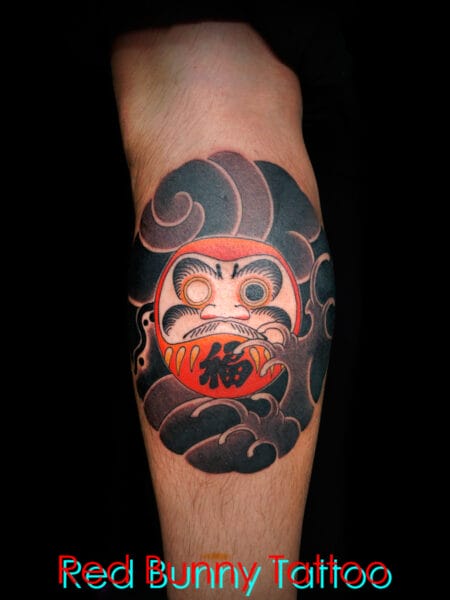
“Red-Bunny Tattoo” is a tattoo studio offering various tattoo services. Their website provides information about their tattooing styles, artists, and the process of getting a tattoo. They likely showcase their portfolio, detailing the types of tattoos they specialize in, such as traditional Japanese or modern designs.
Usage and Cultural Significance of Daruma
- Symbol of Goal Achievement: Daruma are used as a symbol of overcoming challenges to achieve goals, a practice stemming from Bodhidharma’s nine years of meditation facing a wall. A common custom is to paint one eye of the Daruma while making a wish and then the other upon its fulfillment, symbolizing the achievement of objectives.
- As a Lucky Charm: Daruma represents the spirit of “falling seven times but standing up eight,” and is used for various wishes like good health and family safety. The red color of traditional Daruma is also believed to ward off evil spirits.
- Contemporary Use: Daruma remains popular in modern times, used in various contexts such as by athletes and businesses. For instance, professional baseball teams use Daruma as talismans for success at the start of the season. There’s also a custom of burning Daruma dolls in mochi-making ceremonies to pray for good health.
- Diverse Designs: The design of Daruma has diversified, with various colors, sizes, and even artistic versions being created. They are popular internationally as symbols of Japanese culture.
In summary, Daruma plays a significant role in traditional Japanese culture, loved by many as charms for happiness and goal fulfillment. Its usage and design continue to evolve in modern times.
Regional Variations of Daruma in Japan
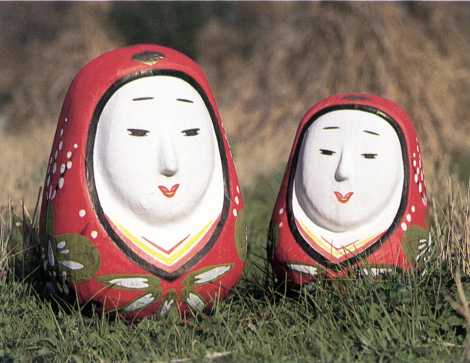
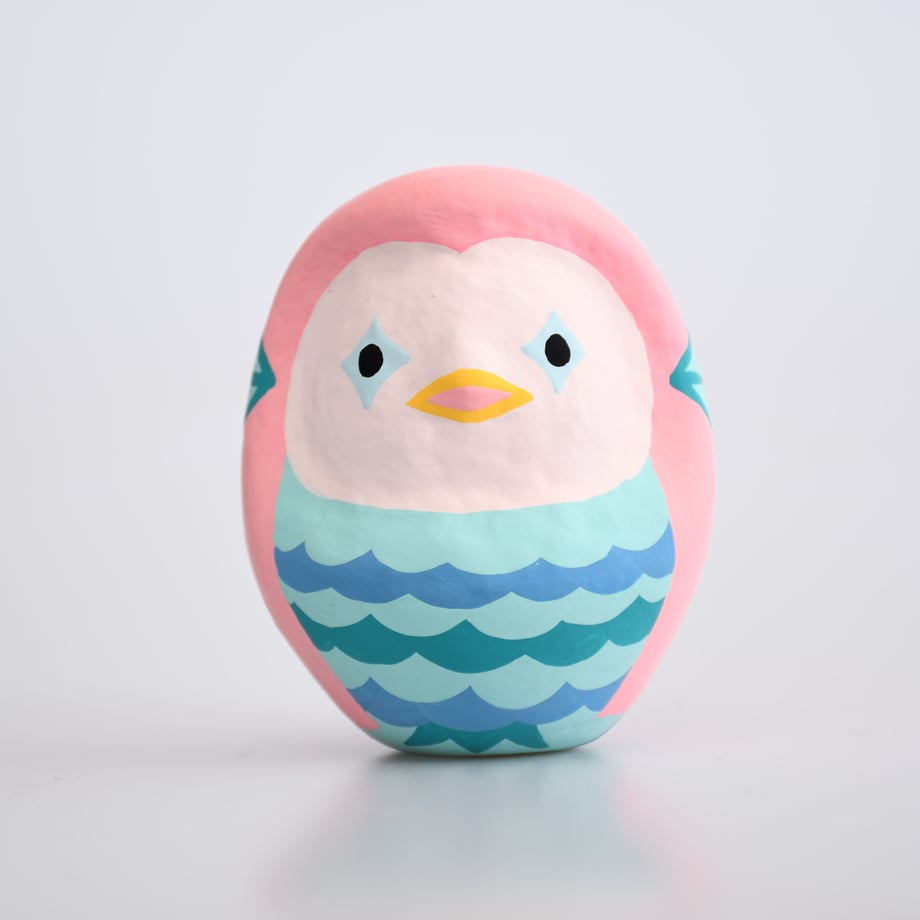
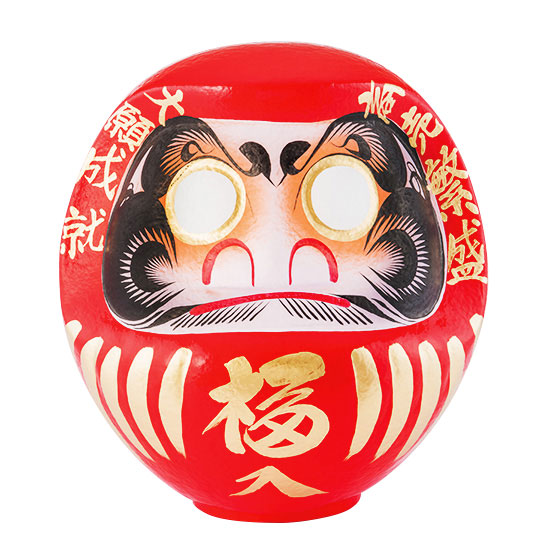
- Hime Daruma (Oita Prefecture, Taketa City): In Taketa City, Oita Prefecture, Hime Daruma are made, which have a history dating back to the Edo period. Known as female Daruma, their popularity surged after being featured on the TV program “Wednesday Downtown.” These Daruma are said to be modeled after housewives from the Edo period.
- Amabie Daruma: As a response to the COVID-19 pandemic, Daruma dolls featuring Amabie, a mythical creature believed to ward off plagues, have been created. These Daruma are sold by various brands and stores, embodying wishes for the end of the pandemic.
- Takasaki Daruma (Gunma Prefecture): Takasaki Daruma, from Gunma Prefecture, account for about 80% of Japan’s Daruma market. They are characterized by designs that include cranes on the eyebrows and turtles on the mustache and beard. Known as “Fuku Daruma” or “Engi Daruma,” they are available in about 15 different colors.
These examples represent just a part of Japan’s diverse Daruma culture. Each region’s unique Daruma reflects its local history and cultural nuances, making it a fascinating topic.
Modern Role and Influence of Daruma
In contemporary society, Daruma dolls play various roles and have diverse impacts, especially in the realms of cultural diplomacy, pop culture, and consumer behavior.
From the perspective of pop culture, Japanese manga and anime are pivotal in deepening the global understanding of Japanese culture. Separating these cultural values from commercial activities is impractical, as many artistic endeavors initially seen as subculture or non-mainstream have later been recognized for their cultural and artistic merit.
In terms of consumer behavior, research shows that pop culture significantly influences consumer actions and lifestyles. The widespread use of the internet and social media has increased global exposure to various cultures’ pop cultures, impacting cultural diversity and consumer behavior. This highlights the significant role pop culture plays in globalization.
From these viewpoints, Daruma, as part of traditional Japanese culture, has found new relevance and impact in modern society. Daruma motifs are used in art, commercial products, and as elements in pop culture, transcending their traditional meanings to create new expressions and values within contemporary culture and commerce. This reflects the growing international recognition of the diversity and historical depth of Japanese culture.

